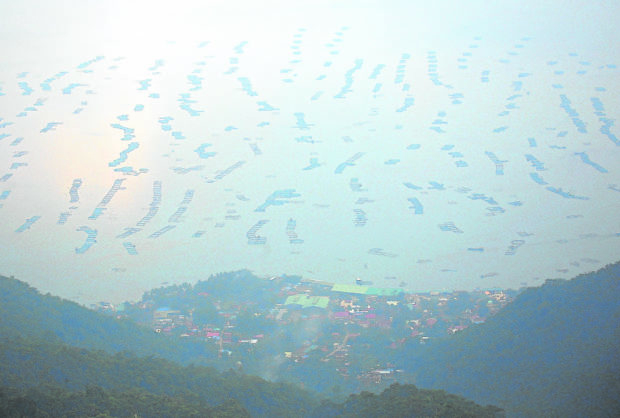Taal not to blame for Metro Manila smog – Phivolcs

IN A VOG Taal Lake becomes a hazy memory of fish pens as sulfur dioxide emissions from Taal Volcano blanket the volcano island and the towns overlooking it. According to the Philippine Institute of Volcanology and Seismology (Phivolcs), the country’s second most active volcano spewed 14,326 tons of gas emissions on Monday, forcing residents of Talisay town in Batangas to stay indoors. —LYNRILLON
Don’t blame Taal Volcano; the haze over Metro Manila on Monday was “most likely caused by human activities,” the Philippine Institute of Volcanology and Seismology (Phivolcs) said on Tuesday.
State volcanologists said the smog over the capital region was due to pollution, most likely from vehicle emissions, and not from the volcanic smog or vog from Taal Volcano, where a rise in sulfur dioxide emissions has been observed.
“The steam and gas plume over Taal Volcano is toward the northeast and not toward Metro Manila,” said Science Undersecretary Renato Solidum Jr., Phivolcs officer in charge.
“You can see this pollution clearly in the morning when the temperature is cooler as the sun has just risen,” Solidum said, adding that the haze moves from the ground up and should eventually rise as air temperature increases during the day.
However, a temperature or thermal inversion prevented the smog from rising, as a layer of warm air trapped the layer of cool air beneath it, along with smog and other pollutants and particulates, according to the Philippine Atmospheric, Geophysical and Astronomical Services Administration (Pagasa) station in Tanay, Rizal province.
Article continues after this advertisementIn Batangas, the vog from the continuous sulfur dioxide emission has forced residents of Talisay town, particularly children and the elderly, to stay indoors. They have been advised to wear N95 face masks when going out.
Article continues after this advertisementHarmful
Peter John Mirania, Talisay’s disaster risk reduction and management official, said on Tuesday the vog could cause eye and throat irritation and pose a threat to the health of persons with respiratory illnesses.
According to Phivolcs, the vog is particularly harmful to the elderly, pregnant women, children and people with health conditions such as asthma, heart disease and lung disease.
Chronic lower respiratory infection was the eighth leading cause of death in the country last year, based on preliminary data released by the Philippine Statistics Authority (PSA).
The PSA data showed 19,463 deaths due to chronic lower respiratory infections from January to December last year, next only to 19,758 deaths that were listed as “virus not identified” or COVID-19 related cases not confirmed by swab tests.
The Phivolcs on Tuesday said “high levels of volcanic sulfur dioxide or SO2 gas emissions and steam-rich plumes that rose as high as 2,500 meters have been observed from the Taal main crater.”
Along with an atmospheric temperature of 30 degrees, relative humidity, and the near-absence of air movement, the emissions caused the volcanic smog that resulted in a haze over the region.
Volcanologists recorded high levels of gas emissions over the weekend, averaging 4,771 tons per day on Sunday. On Monday, June 28, SO2 emissions were at 14,326 tons per day.
Alert Level 2 or “increased unrest” is currently raised on Taal Volcano which, authorities said, means that “sudden steam- or gas-driven explosions, volcanic earthquakes, minor ash fall, and lethal accumulations or expulsions of volcanic gas can occur and threaten areas within and around TVI (Taal Volcano Island).”